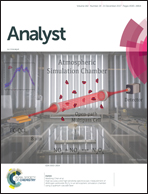Engineering high-performance hairpin stacking circuits for logic gate operation and highly sensitive biosensing assay of microRNA†
Abstract
Recently, hairpin stacking circuits (HSC) based on toehold-mediated strand displacement have been engineered to detect nucleic acids and proteins. However, the three metastable hairpins in a HSC system can potentially react non-specifically in the absence of a catalyst, limiting its practical application. Here, we developed a unique hairpin design guideline to eliminate circuit leakage of HSC, and the high-performance HSC was successfully implemented on logic gate building and biosensing. We began by analyzing the sources of circuit leakage and optimizing the toehold lengths of hairpins in the HSC system based on the surface plasmon resonance (SPR) technique. Next, a novel strategy of substituting two nucleotides in a specific domain, termed ‘loop-domain substitution’, was introduced to eliminate leakages. We also systematically altered the positions and numbers of the introduced substitutions to probe their potential contribution to circuit leakage suppression. Through these efforts, the circuit leakage of HSC was significantly reduced. Finally, by designing different DNA input strands, the logic gates could be activated to achieve the output signal. Using miRNA as a model analyte, this strategy could detect miRNA down to pM levels with minimized circuit leakage. We believe these work indicate significant progress in the DNA circuitry.



 Please wait while we load your content...
Please wait while we load your content...